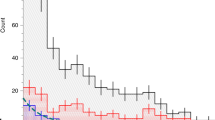Abstract
An unresolved problem regarding ancient astronomical records is that of the star ‘Red Sirius’. While Sirius today shines white with a blueish hue quite in agreement with its spectral type AIV, many Greek/Roman and Babylonian sources (although still disputed) definitely assign a red colour to this star. We now present new and apparently independent information about Red Sirius from an early-medieval manuscript. This manuscript is of Lombardic origin (8th century) and contains the otherwise lost ‘De cursu stellarum ratio’ by Gregory of Tours (about AD 538–593). It is preserved in the library of Bamberg1. Red stars in ancient records are those with colour index B−V = 1.0 or greater. Assuming an unchanged Sirius A, this lower limit for the combined colour of Sirius A and B allows the computation of the region of pre-white dwarf Sirius B in the Hertzsprung–Russell diagram or colour–magnitude diagram (Figs 1, 2). Sirius B lies on the giant branch, which fits well with our observational and theoretical framework of stellar evolution. However, the timescale of transformation of a red giant to a white dwarf is surprisingly short.
This is a preview of subscription content, access via your institution
Access options
Subscribe to this journal
Receive 51 print issues and online access
$199.00 per year
only $3.90 per issue
Buy this article
- Purchase on Springer Link
- Instant access to full article PDF
Prices may be subject to local taxes which are calculated during checkout
Similar content being viewed by others
References
Bamberg Library Manuscript Identification Code:, H.I., IV, 15 (s.VIII), f. 79–82′.
Gundel, W. in Realencyclopädie der Classischen Altertumswissenschaften Vol. II.5 (eds Pauly, A. & Wissowa, G.) cols 314–351 (Druckenmüller, Stuttgart, 1927).
Gössmann, F. Planetarium Babylonicum (Scripta Pontificii Instituti Biblici, Rome 1950).
Brecher, K. & Feirtag, M. (eds) Astronomy of the Ancients, 91–115 (MIT Press, Cambridge, 1979).
Hoffleit, D. Bright Star Catalogue (Yale University Observatory, New Haven, 1982).
Allen, C. W. Astrophysical Quantities 3rd Edn, 144 (University of London, 1973).
Houk, N. & Fesen, R. IAU Symp. 80, 91 (1978).
Ciardullo, R. B. & Demarque, P. Dudley Obs. Rep. 14, 317 (1979).
Schmidt-Kaler, Th. in Landolt-Börnstein Vol. 2b (eds Schaifers, K. & Voigt, H. H.) 1 (Sprittgef, Berlin, 1982).
Author information
Authors and Affiliations
Rights and permissions
About this article
Cite this article
Schlosser, W., Bergmann, W. An early-medieval account on the red colour of Sirius and its astrophysical implications. Nature 318, 45–46 (1985). https://doi.org/10.1038/318045a0
Received:
Accepted:
Published:
Issue Date:
DOI: https://doi.org/10.1038/318045a0
This article is cited by
-
Did Sirius change colour?
Nature (1991)
-
Sirius and the colour enigma
Nature (1990)
-
Concluding remarks
Astrophysics and Space Science (1988)
-
The colour of Sirius in the sixth century
Nature (1987)
-
The colour of Sirius in the sixth century
Nature (1987)
Comments
By submitting a comment you agree to abide by our Terms and Community Guidelines. If you find something abusive or that does not comply with our terms or guidelines please flag it as inappropriate.



